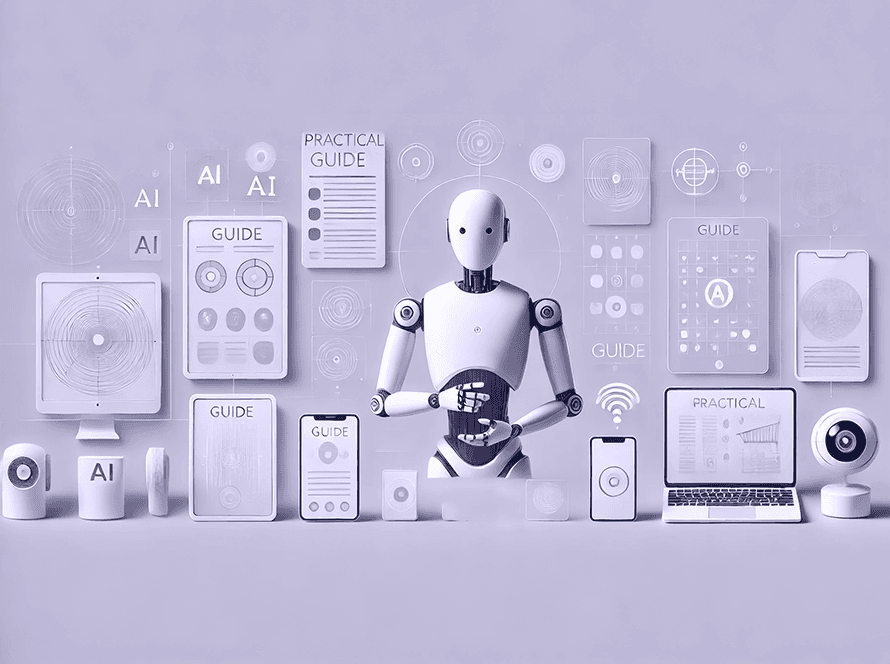“Use AI for B2B Waste Management Sales to automate cold calls, find expiring contracts, and strategically schedule high-density site audits.”
The rhythmic click of the phone dialing. The brief, hopeful ring. The inevitable, “Hello, you’ve reached the voicemail for…” It’s a sound every sales rep in the commercial waste management industry knows all too well. It’s the sound of the daily grind, the sound of prospecting. For decades, the path to growing a waste management business has been paved with sheer brute force—countless hours spent cold-calling local businesses, hunting for that sliver of opportunity: a decision-maker with a waste disposal contract nearing expiration.
This high-volume, relationship-driven sales process is both an art and a science. But let’s be honest, the “science” part has been stuck in the past. Your sales team, your most valuable asset, spends an astonishing amount of its time on the lowest-value activity: dialing for dollars. They are expert consultants, skilled negotiators, and champions of environmental services. Yet, they are often relegated to the role of telemarketers, sifting through mountains of “no’s” to find a single “maybe.”
The primary bottleneck is crystal clear. It’s the immense, time-consuming, and soul-crushing manual effort required to gain a foothold. You need to identify businesses, find the right contact, catch them at the right time, and discover if their contract is up for renewal. Only then can you schedule the all-important on-site audit, where the real sales magic happens. But what if you could bypass that bottleneck entirely? What if you could use technology not just to manage your routes, but to fill them?
This is where AI for B2B waste management sales comes in. It’s not a far-off, futuristic concept. It’s a practical, powerful tool available today that is fundamentally changing the sales equation. Imagine an agent that can tirelessly call thousands of local businesses for you, ask the critical qualifying questions, and then, like a perfectly trained assistant, schedule a qualified site audit directly onto your sales rep’s calendar. This article will explore how this technology works and how it can help you find new commercial clients, optimize your logistics, and truly grow your waste management business.
The Brutal Reality of Traditional Prospecting in Waste Management
Before we dive into the solution, it’s crucial to appreciate the problem fully. The challenges of prospecting in the commercial recycling and waste disposal industry aren’t just minor inconveniences; they are fundamental barriers to growth that directly impact your bottom line.
The Tyranny of the Telephone
Cold calling is a numbers game, and the odds are stacked against you. Think about a typical day for one of your sales reps.
- The Sheer Volume: To get even a handful of qualified leads, a rep might need to make 80, 100, or even 150 calls a day. This is a monotonous and repetitive task that can lead to quick burnout and high turnover in sales development roles.
- The Gatekeeper Gauntlet: First, you have to get past the receptionist or office manager. These individuals are trained to shield decision-makers from unsolicited calls and other unwanted communications. Your representative has only seconds to make a compelling case to be transferred to the right person, who is likely busy.
- The Voicemail Abyss: More often than not, the call goes straight to voicemail. The rep leaves a carefully crafted message, but the reality is that callback rates from cold voicemails are abysmally low, often less than 1%.
- The Rejection Factor: For the calls that do get through, the vast majority will be a “no.” “We’re not interested,” “We’re happy with our current provider,” or the classic “We’re locked into a contract.” Constant rejection takes a psychological toll and can crush the motivation of even the most seasoned sales professionals.
Let’s put some hypothetical numbers to this. If a rep makes 100 calls, they might have 15 actual conversations. Of those 15, 5 are with the right person. Of those 5, maybe one is a business with a contract expiring in the next six months that is open to a conversation. That’s a 1% success rate for a full day’s work. One appointment. It’s an incredibly inefficient use of a skilled professional’s time.
The Contract Timing Lottery
The single biggest challenge is timing. Waste disposal contracts are typically long-term agreements, often lasting three, five, or even seven years. This means that on any given day, 95% of the businesses you call are not in a position to switch providers, even if they wanted to. They are legally and financially locked in.
Your sales team is essentially playing the lottery. They are dialing random numbers, hoping to stumble upon a business that fits into a very narrow window of opportunity. This isn’t a strategic sales process; it’s a game of chance. You might have the best service, the most competitive pricing, and the most charming sales rep, but if the timing isn’t right, it’s all for naught.
This creates a “feast or famine” cycle. A rep might get lucky and find a few expiring contracts in one week, leading to a flurry of quotes and activity. Then, they might go the next two weeks with nothing, despite putting in the same amount of effort. This inconsistency makes forecasting and managing a sales pipeline incredibly difficult. Furthermore, it prevents any real strategy beyond “call everyone and hope for the best.”
The Site Audit Paradox: The Goal That Creates the Bottleneck
The on-site audit is the cornerstone of the commercial recycling sales process. It’s where your rep can truly shine. They can see the client’s waste stream firsthand, identify opportunities for recycling that could save them money, assess container size and placement, and build the personal rapport that is so vital in this relationship-driven industry. A quote generated from a site audit is always more accurate and compelling than a blind guess over the phone.
Herein lies the paradox: the very activity that is most crucial for closing a deal is also a massive time sink, preventing the representative from finding more deals.
Consider the logistics involved:
- Scheduling: The initial back-and-forth to find a mutually available time.
- Preparation: Researching the business and preparing materials.
- Travel Time: Driving to and from the client’s location. This is a significant hidden cost, both in terms of fuel and, more importantly, in terms of time.
- The Audit Itself: The meeting can take anywhere from 30 minutes to over an hour.
- Follow-up: Preparing the formal quote and sending it to the prospect.
Every hour a rep spends driving to an audit is an hour they are not prospecting for the next audit. This creates a natural ceiling on a rep’s productivity. They are constantly forced to choose between filling the top of their funnel (prospecting) and moving opportunities through the middle of their funnel (conducting audits). It’s a classic catch-22 that limits the growth potential of your entire operation.
The Hidden Cost of Inefficiency: Why Route Density Matters More Than You Think
Beyond the direct sales challenges, the traditional method of appointment setting creates a significant, often overlooked, operational problem: poor route density optimization.
When a sales rep manages to book an audit through sheer luck and persistence, where is that appointment located? It could be anywhere. One audit might be on the north side of town in the morning, and the next might be on the far south side in the afternoon. This haphazard scheduling forces your sales reps to crisscross their territory all day long.
This isn’t just a minor annoyance; it’s a direct assault on your profitability.
- Wasted Fuel: The cost of gasoline is a significant and variable expense. Unnecessary driving directly increases your overhead.
- Lost Time: The most valuable resource your sales rep has is their time. An hour spent in traffic is an hour they can’t be prospecting or meeting with another potential client. This “windshield time” is the enemy of productivity. If a rep spends two hours a day driving between appointments, that’s ten hours a week—more than a full workday—lost forever.
- Operational Drag: This inefficiency extends beyond just the sales team. When a deal is closed, the new client’s location might be far from your existing collection routes. This can increase the time and fuel costs for your drivers, decreasing the overall profitability of that new contract.
Ideally, you want your sales team to schedule audits in tight, logical clusters. Imagine a rep spending an entire day in a single industrial park, going from one audit to the next with only a five-minute drive in between. They could conduct five or six audits in the same amount of time it took them to do two or three, spread across the city. This level of efficiency is impossible to achieve when your prospecting method is based on random luck. Achieving high route density for both sales and operations is a key lever to grow a waste management business. Still, it’s a lever that manual prospecting simply cannot pull effectively.

The New Frontier: An AI Sales Agent for Your Waste Business
Now, imagine a different way. Imagine you had a new team member. This team member is incredibly persistent, never gets tired, and works 24/7. They can make thousands of phone calls a day without ever getting discouraged. They are experts at asking the right questions, and their sole goal is to fill your sales reps’ calendars with qualified, interested prospects who are ready for a site audit.
This isn’t a person. It’s an AI-powered conversational voice agent, and it’s the core of sales tools for environmental services, such as SalesCloser.ai.
What Exactly Is an AI Sales Agent?
Let’s demystify the term. This isn’t a physical robot or a chatbot on a website. It’s a sophisticated piece of software that uses artificial intelligence to conduct natural, human-like conversations over the phone. It’s designed to handle the repetitive, top-of-funnel tasks that consume a significant portion of a human sales representative’s time.
Think of it as the ultimate Sales Development Representative (SDR). You provide it with a list of businesses to call and a script with key qualifying questions. The AI then gets to work, dialing the numbers and engaging prospects in conversation.
The key is its conversational ability. Modern AI has moved far beyond robotic, monotone voices. It can understand context, respond to questions, and maintain the flow of a natural conversation. It can be programmed to be polite, professional, and on-brand, representing your company exactly as you’d want.
The AI Prospecting Workflow in Action
The process is remarkably straightforward and robust. It transforms the chaos of manual prospecting into a streamlined, predictable system for scheduling B2B services.
Step 1: Define and Target.t You start with the fundamentals: who is your ideal customer? You can build lists based on geography (e.g., every business in a specific zip code or industrial park), industry (e.g., all restaurants, manufacturing plants, or property management companies), or even specific company names. This allows you to be highly strategic. Want to improve route density in the eastern quadrant of your service area? Simple. Feed the AI a list of every business in that quadrant.
Step 2: The AI Goes to Work Once the AI has its list, it begins dialing. It can make hundreds of calls an hour, a volume that is physically impossible for a human to handle. It navigates phone trees, handles initial greetings, and works to reach the person in charge of vendor contracts.
Step 3: The Qualifying Conversation. This is where the magic happens. The AI engages the prospect with a series of pre-programmed but conversational questions designed to identify a qualified lead. The conversation might sound something like this:
AI Agent: “Hi, my name is Alex, and I’m calling from Acme Waste Solutions. I was hoping to speak with the person who manages your waste and recycling services.”
Prospect: “That would be me. What’s this about?”
AI Agent: “Great! I’m calling because we’re a local provider, and we’ve helped many other businesses in your area reduce their waste disposal costs. I was just calling to ask, who are you currently using for your service?”
Prospect: “We use National Waste Co.”
AI Agent: “Got it. And are you generally happy with their service? Out of curiosity, do you happen to know when your current agreement with them is set to expire?”
Prospect: “You know, I think it’s coming up in the next few months, maybe in the spring.”
AI Agent: “That’s perfect timing. What we typically do is offer a no-obligation site audit. One of our specialists can visit, inspect your setup, and provide a complimentary quote. It’s a great way to see if you’re getting the best possible rate. Would you be open to something like that?”
Step 4: Seamless Calendar Integration. If the prospect agrees, the AI’s final task is to schedule the appointment. It integrates directly with your sales team’s Google or Outlook calendars.
AI Agent: “Excellent. My specialist, Dave, is in your area next week. Does Tuesday or Thursday afternoon work better for a quick 20-minute walkthrough?”
Prospect: “Thursday afternoon is good.”
AI Agent: “Perfect. I see Dave has an opening at 2:00 PM on Thursday. Does that work?”
Prospect: “Yes, that’s fine.”
AI Agent: “Great! I’ve just sent a calendar invitation to you for Thursday at 2:00 PM with Dave. You’ll get a confirmation email shortly. Thanks so much for your time!”
And just like that, a qualified site audit appears on your rep’s calendar. No dialing, no rejection, no wasted time. The rep simply sees the appointment, prepares for it, and goes to do what they do best: build a relationship and close the deal. This is how you automate commercial quotes at the top of the funnel, creating a predictable flow of opportunities.
The Transformative Benefits: From Surviving to Thriving
Implementing an AI prospecting agent isn’t just an incremental improvement. It’s a fundamental shift in how your sales operation functions, unlocking a level of efficiency and growth that was previously unimaginable.
Benefit 1: Dramatically Increase Your Volume of Qualified Appointments
This is the most immediate and impactful benefit. Your best human sales rep can book one, two, or on a great day, three site audits. An AI agent can book five, ten, or even more appointments per day, per rep.
By taking the massive, time-consuming task of prospecting off your reps’ plates, you remove the primary bottleneck in your sales process. The AI acts as a force multiplier, leveraging technology to do the heavy lifting of sifting and qualifying. Your sales pipeline, once a trickle, becomes a steady, predictable river of qualified opportunities. This consistent flow allows for more accurate sales forecasting and creates a more stable, less stressful environment for your sales team. They are no longer judged by their call volume but by what truly matters: their closing rate on the high-quality appointments the AI provides.
Benefit 2: Free Your Sales Reps to Be Closers, Not Callers
Your sales representatives are skilled professionals. Their expertise lies in understanding a client’s needs, analyzing waste streams, explaining the benefits of your service, and negotiating waste disposal contracts. Every minute they spend looking up a phone number or leaving a voicemail is a minute of their expensive, high-level talent being wasted on a low-level task.
By automating the prospecting, you empower your reps to focus 100% of their energy on revenue-generating activities. Their days are no longer a grind of cold calling but a strategic series of on-site audits, proposal preparations, and follow-up meetings. This not only makes them vastly more productive but also dramatically increases their job satisfaction. They get to do more of what they’re good at and less of what they hate. This leads to lower turnover, higher morale, and, ultimately, more closed deals. You hired them to sell, and now you can finally let them.
Benefit 3: Master Your Logistics and Achieve Perfect Route Density
Remember the problem of haphazard scheduling and wasted “windshield time”? AI completely solves this. It enables you to transition from a reactive to a proactive approach for logistics in waste services and sales.
With an AI agent, you can be incredibly strategic about your prospecting.
- Geographic Targeting: You can instruct the AI to target all businesses within a specific five-mile radius for an entire week. The result? Your sales rep’s calendar for that week will be filled with audits that are just minutes apart. They can move from one appointment to the next with maximum efficiency.
- Building New Routes: Want to expand into a new territory? Before you even commit a truck, you can have the AI blanket the area with calls, gauge interest, and pre-fill a pipeline of potential clients. This enables you to establish a robust, profitable route from the outset.
- Filling in Gaps: Do you have an existing route with a few unprofitable gaps between clients? You can feed the AI a list of every business located between those clients. The AI will work to sign up new customers who are directly on your existing truck routes, instantly making those routes more profitable.
This strategic route density optimization saves thousands of dollars in fuel and adds hundreds of productive hours back into your sales team’s schedule over the course of a year.
Benefit 4: Turn Every Call into Actionable Market Intelligence
What happens when a human rep gets a “no”? Usually, they just hang up and move on to the next call. The reason for the “no” is lost forever. An AI agent is different. It logs the outcome of every single call.
This creates an invaluable database of market intelligence. After the AI has called a few thousand businesses, you’ll have precise data on:
- Competitor Contracts: You’ll know which of your competitors holds which contracts and, most importantly, when those contracts are set to expire. You can use this data to build a long-term follow-up strategy, automatically reaching out to those businesses 90 days before their contract expiration.
- Common Pain Points: The AI can be programmed to ask about service satisfaction. You might discover that a particular competitor is consistently failing on pickup times or has confusing billing, giving your sales team the perfect angle for their pitch.
- Market Penetration: You’ll have a crystal-clear map of who holds which contracts in any given territory, allowing you to identify your strengths, weaknesses, and opportunities for growth.
This data transforms your sales and marketing efforts from guesswork into a data-driven science.
A Day in the Life: The “Before” and “After” of AI Prospecting
To make this tangible, let’s follow a hypothetical sales rep named Dave.
Dave’s Day: Before AI
- 8:00 AM: Arrives at the office, gets coffee, and pulls up his list of 150 local businesses to call.
- 8:30 AM – 11:30 AM: The Grind. He makes 75 calls. He speaks to 10 people, gets yelled at once, leaves 40 voicemails, and is told “not interested” by 9 of the people he speaks to. He has zero appointments.
- 11:30 AM: Finally! He gets a decision-maker on the phone who says their contract is up in four months. He manages to book a site audit. It’s for tomorrow afternoon, a 45-minute drive across town.
- 12:00 PM: Lunch at his desk while researching the company for tomorrow’s audit.
- 1:00 PM: He has another audit scheduled for today at 2:30 PM, on the complete opposite side of town. He leaves now to beat traffic.
- 2:30 PM – 3:15 PM: Conducts the audit. It goes well, but the prospect seems non-committal.
- 3:15 PM – 4:15 PM: Sits in traffic driving back to the office.
- 4:15 PM – 5:00 PM: Back at his desk, he attempts to make a few more calls but feels drained. He leaves a few more voicemails and updates his CRM.
- Result of the day: 100+ calls made, 2 hours in the car, one new appointment booked. He feels exhausted.
Dave’s Day: After AI
- 8:00 AM: Arrives at the office, gets coffee, and opens his calendar. He sees that overnight, the AI agent has booked five new site audits for him over the next two days.
- 8:15 AM: He looks at the calendar and smiles. All five appointments are located in the same industrial park.
- 8:15 AM – 10:00 AM: He spends his time thoroughly researching all five companies, preparing custom materials, and strategizing his approach for each one. He feels prepared and confident.
- 10:00 AM: He drives 20 minutes to the industrial park. He will stay in this area all day.
- 10:30 AM: First audit. It goes great.
- 11:30 AM: Second audit, just a three-minute drive away.
- 12:30 PM: He takes a client from his first audit out for a quick lunch to build rapport.
- 2:00 PM: Third audit.
- 3:30 PM: He has a break in his schedule, so he uses the time to draft and send out the three proposals from his morning meetings while the details are still fresh.
- 4:30 PM: He heads home, having avoided all rush-hour traffic.
- Result of the day: Zero cold calls made, less than 45 minutes of driving, three audits completed, three proposals sent, and one client relationship strengthened. He feels energized and productive.
The difference is night and day. The AI doesn’t replace Dave; it makes him a superhero. It handles the monotonous work, allowing him to apply his skills where they create the most value.
It’s Time to Stop Dialing and Start Closing
The commercial waste management industry is competitive. The companies that will win in the next decade are the ones that embrace technology to create efficiencies their competitors can’t match. Continuing to rely solely on manual cold calling is like insisting on using a horse and buggy when your competition has a fleet of trucks.
By implementing an AI sales agent, you can solve the single biggest problem in your sales process. You can stop wasting your most valuable resources—your sales reps’ time and talent—on low-value, high-volume prospecting. You can create a predictable, scalable machine for generating qualified site audits, allowing your team to do what you hired them for: building relationships and closing deals.
Stop playing the contract timing lottery. Stop burning out your sales team. Stop accepting inefficient routes as a cost of doing business. It’s time to leverage the power of AI for B2B waste management sales to build a smarter, faster, and more profitable growth engine for your company.
Frequently Asked Questions (FAQs)
1. How is this different from a simple auto-dialer?
An auto-dialer is a “dumb” tool. It simply dials numbers from a list and connects a live call to an available agent. It doesn’t have a conversation, it doesn’t qualify anyone, and it still requires a human to do all the talking. An AI for B2B waste management sales, on the other hand, is a “smart” tool. It utilizes conversational AI to facilitate a comprehensive, two-way conversation. It can understand intent, answer basic questions, and make decisions based on the flow of the dialogue. It handles the entire prospecting and qualifying process from start to finish.
2. Will the AI sound robotic and annoy potential customers?
This is a common and valid concern. However, modern conversational AI has made incredible leaps. The technology used by platforms like SalesCloser.ai features incredibly human-like voices, with natural-sounding intonation, pacing, and inflection. While it’s essential to be transparent about the caller being an AI assistant, most people are surprised at how natural the conversation feels. The goal isn’t to trick anyone; it’s to have a clear, efficient, and professional interaction to see if there’s a potential fit.
3. What happens if a prospect asks a complex question that the AI doesn’t understand?
This is a key part of the system’s design. The AI is trained to handle a specific set of questions and conversational paths related to qualifying and scheduling. If a prospect asks a highly technical question about recycling services or a complex contractual question, the AI is programmed to handle it gracefully. It can say, “That’s an excellent question that is best answered by one of our senior account managers. I can have them call you back, or I can schedule a meeting for you. Which would you prefer?” This ensures that complex inquiries are seamlessly handed off to a human expert without frustrating the prospect.
4. Is this difficult to set up and manage?
No. Leading platforms in this space are designed to be user-friendly. The process typically involves a simple onboarding where you work with the provider to:
- Upload your contact lists.
- Customize the script with your company’s name and value proposition.
- Connect your sales team’s calendars.
- Set the rules for the campaign (e.g., what days and times to call).
Once it’s launched, you’ll gain access to a dashboard where you can monitor real-time results, listen to call recordings, and view your reps’ calendars as they fill up. It’s a “set it and forget it” tool that works tirelessly in the background.
5. Is using an AI for outreach compliant with regulations?
Compliance is paramount. Reputable providers of sales tools for environmental services are well-versed in regulations like the Telephone Consumer Protection Act (TCPA). These AI systems are designed for B2B (business-to-business) calls, which generally have different rules than B2C (business-to-consumer) calls. Furthermore, because the system is calling business landlines to manage service inquiries and schedule appointments, it operates within established legal frameworks. It’s always wise to discuss specific compliance questions with the service provider.








